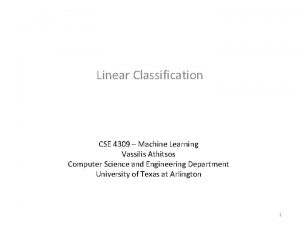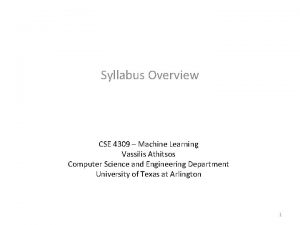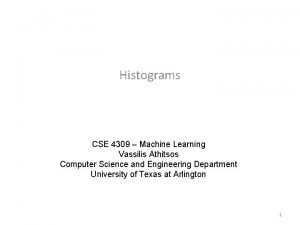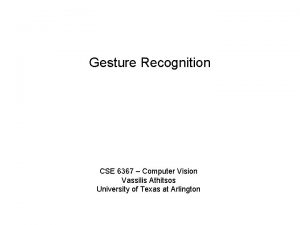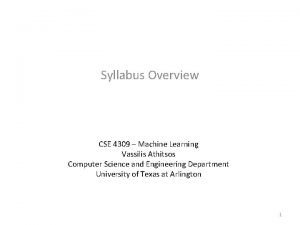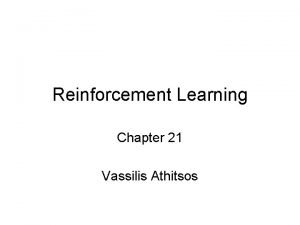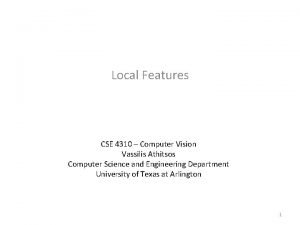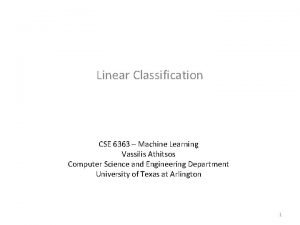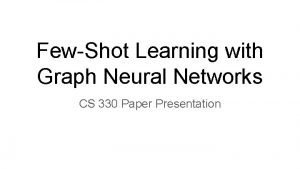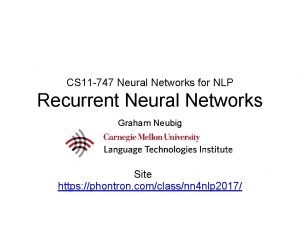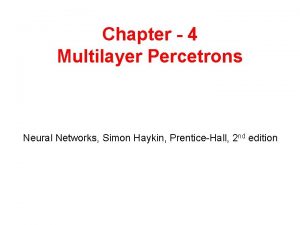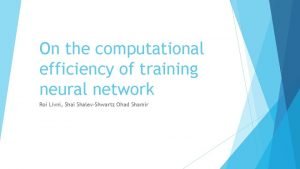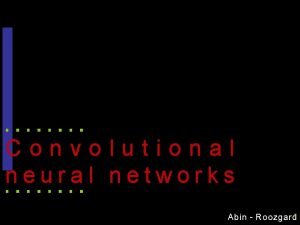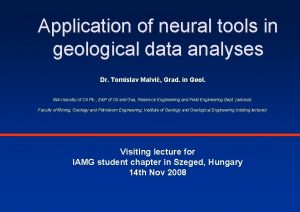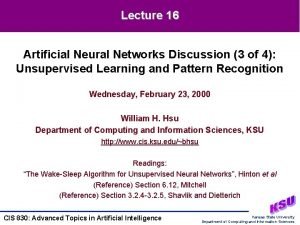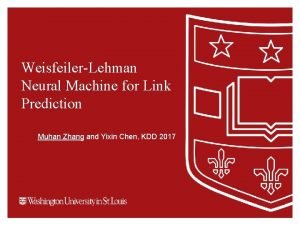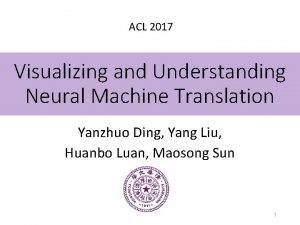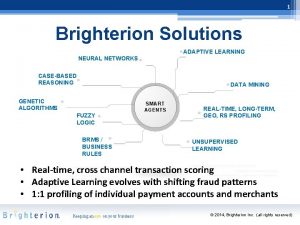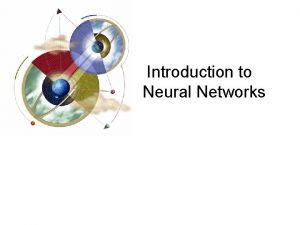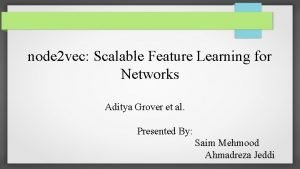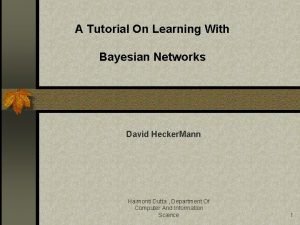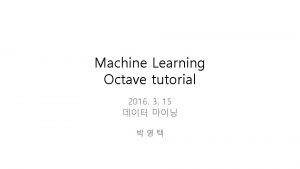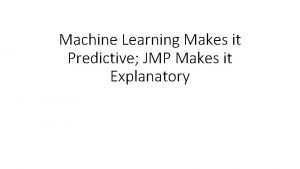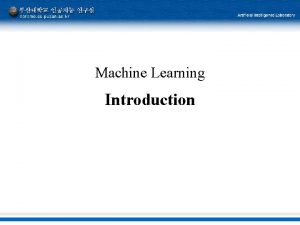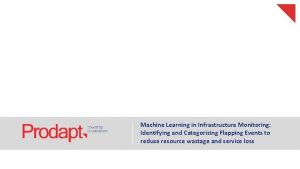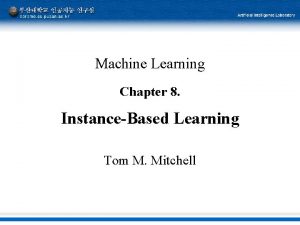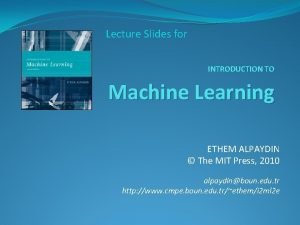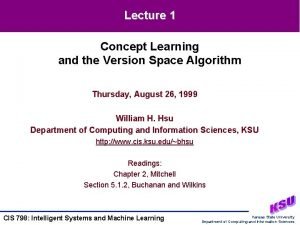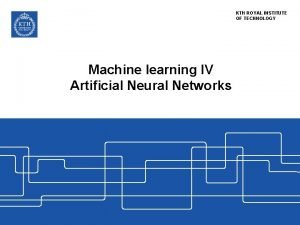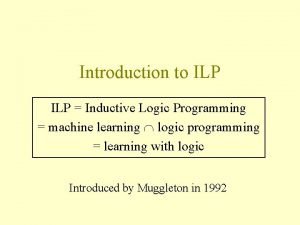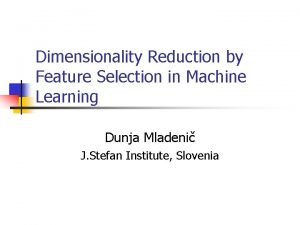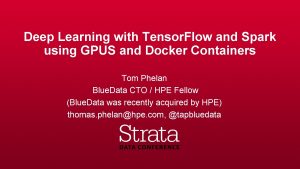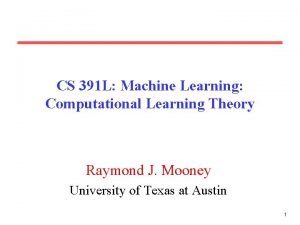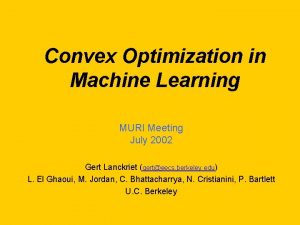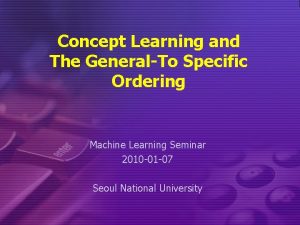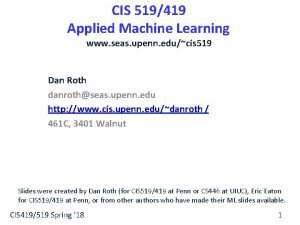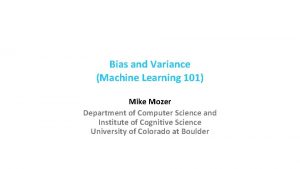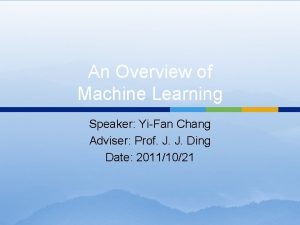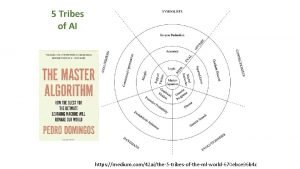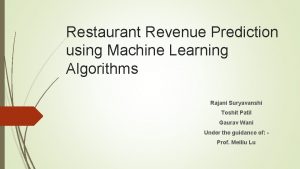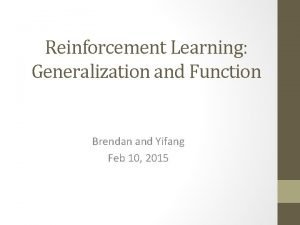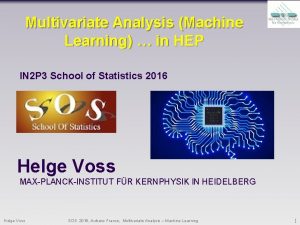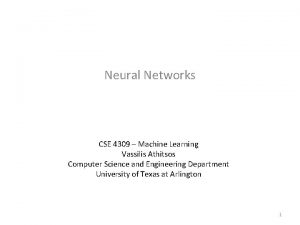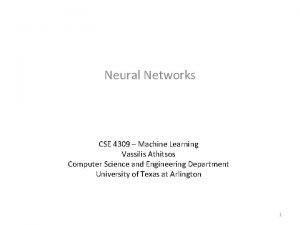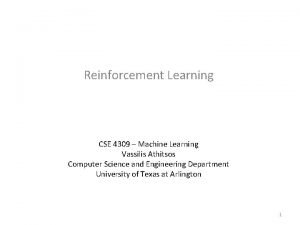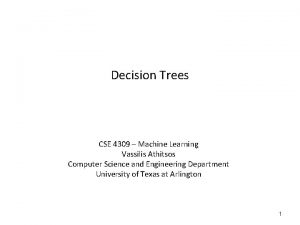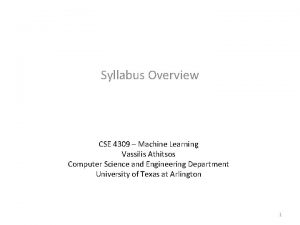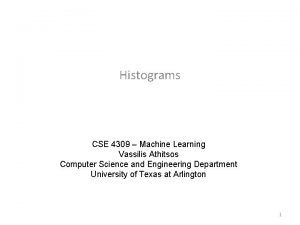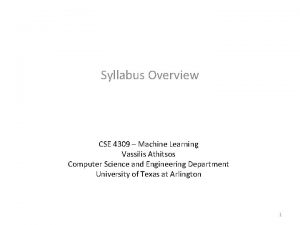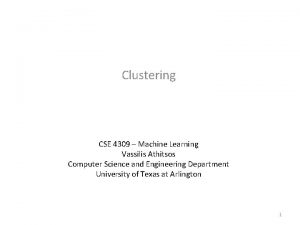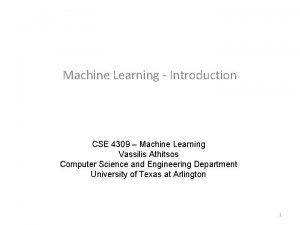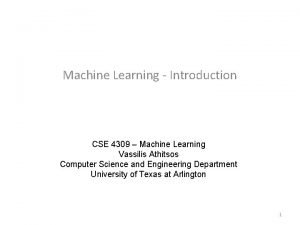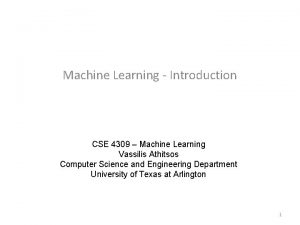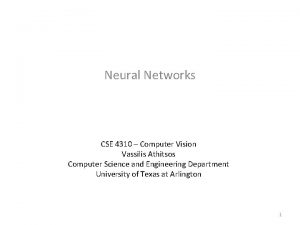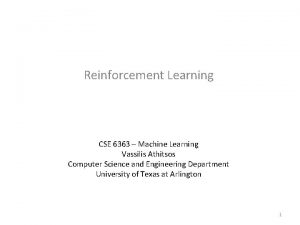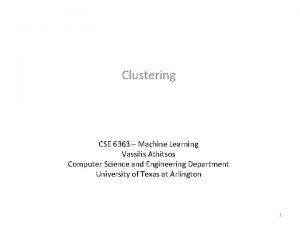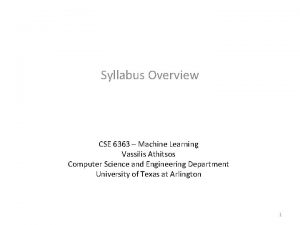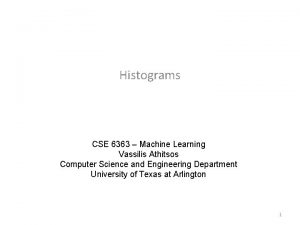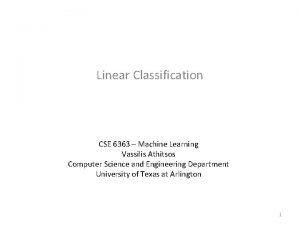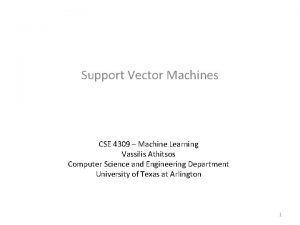Neural Networks CSE 4309 Machine Learning Vassilis Athitsos









































































































- Slides: 105

Neural Networks CSE 4309 – Machine Learning Vassilis Athitsos Computer Science and Engineering Department University of Texas at Arlington 1

Perceptrons • 2

Perceptrons • 3

Perceptrons • 4

Perceptrons • 5

Perceptrons and Neurons • Perceptrons are inspired by neurons. – Neurons are the cells forming the nervous system, and the brain. – Neurons somehow sum up their inputs, and if the sum exceeds a threshold, they "fire". • Since brains are "intelligent", computer scientists have been hoping that perceptron-based systems can be used to model intelligence. 6

Activation Functions • 7

Activation Functions • 8

Example: The AND Perceptron • • Suppose we use the step function for activation. Suppose boolean value false is represented as number 0. Suppose boolean value true is represented as number 1. Then, the perceptron below computes the boolean AND function: false AND false = false AND true = false true AND false = false true AND true = true 9

Example: The AND Perceptron • false AND false = false AND true = false true AND false = false true AND true = true 10

Example: The AND Perceptron • false AND false = false AND true = false true AND false = false true AND true = true 11

Example: The AND Perceptron • false AND false = false AND true = false true AND false = false true AND true = true 12

Example: The AND Perceptron • false AND false = false AND true = false true AND false = false true AND true = true 13

Example: The OR Perceptron • • Suppose we use the step function for activation. Suppose boolean value false is represented as number 0. Suppose boolean value true is represented as number 1. Then, the perceptron below computes the boolean OR function: false OR false = false OR true = true OR false = true OR true = true 14

Example: The OR Perceptron • false OR false = false OR true = true OR false = true OR true = true 15

Example: The OR Perceptron • false OR false = false OR true = true OR false = true OR true = true 16

Example: The OR Perceptron • false OR false = false OR true = true OR false = true OR true = true 17

Example: The OR Perceptron • false OR false = false OR true = true OR false = true OR true = true 18

Example: The NOT Perceptron • • Suppose we use the step function for activation. Suppose boolean value false is represented as number 0. Suppose boolean value true is represented as number 1. Then, the perceptron below computes the boolean NOT function: NOT(false) = true NOT(true) = false 19

Example: The NOT Perceptron • NOT(false) = true NOT(true) = false 20

Example: The NOT Perceptron • NOT(false) = true NOT(true) = false 21

The XOR Function false XOR false = false XOR true = true XOR false = true XOR true = false • As before, we represent false with 0 and true with 1. • The figure shows the four input points of the XOR function. – green corresponds to output value true. – red corresponds to output value false. • The two classes (true and false) are not linearly separable. • Therefore, no perceptron can compute the XOR function. 22

Our First Neural Network: XOR • A neural network is built using perceptrons as building blocks. • The inputs to some perceptrons are outputs of other perceptrons. • Here is an example neural network computing the XOR function. Unit 3 Unit Output: 5 Unit 4 23

Our First Neural Network: XOR • Unit 3 Unit Output: 5 Unit 4 24

Our First Neural Network: XOR • The XOR network shows how individual perceptrons can be combined to perform more complicated functions. OR unit A AND (NOT B) AND unit Output: 25

Computing the Output: An Example • OR unit A AND (NOT B) AND unit Output: 26

Computing the Output: An Example • OR unit A AND (NOT B) AND unit Output: 27

Computing the Output: An Example • OR unit A AND (NOT B) AND unit Output: 28

Computing the Output: An Example • OR unit A AND (NOT B) AND unit Output: 29

Verifying the XOR Network • OR unit A AND (NOT B) AND unit Output: 30

Verifying the XOR Network • OR unit A AND (NOT B) AND unit Output: 31

Verifying the XOR Network • OR unit A AND (NOT B) AND unit Output: 32

Neural Networks • This neural network example consists of six units: – Three input units (including the not-shown bias input). – Three perceptrons. • Yes, in the notation we will be using, inputs count as units. Unit 3 Unit Output: 5 Unit 4 33

Neural Networks • Unit 3 Unit Output: 5 Unit 4 34

Neural Network Layers • • Oftentimes, neural networks are organized into layers. The input layer is the initial layer of input units (units 0, 1, 2 in our example). The output layer is at the end (unit 5 in our example). Zero, one or more hidden layers can be between the input and output layers. Unit 3 Unit Output: 5 Unit 4 35

Neural Network Layers • • • There is only one hidden layer in our example, containing units 4 and 5. Each hidden layer's inputs (except bias inputs) are outputs from previous layer. Each hidden layer's outputs are inputs to the next layer. The first hidden layer's inputs come from the input layer. The last hidden layer's outputs are inputs to the output layer. Unit 3 Unit Output: 5 Unit 4 36

Feedforward Networks • Feedforward networks are networks where there are no directed loops. • If there are no loops, the output of a neuron cannot (directly or indirectly) influence its input. • While there are varieties of neural networks that are not feedforward or layered, our main focus will be layered feedforward networks. Unit 3 Unit Output: 5 Unit 4 37

Computing the Output • Unit 3 Unit Output: 5 Unit 4 38

Computing the Output • Unit 3 Unit Output: 5 Unit 4 39

What Neural Networks Can Compute • An individual perceptron is a linear classifier. – The weights of the perceptron define a linear boundary between two classes. • Layered feedforward neural networks with one hidden layer can compute any continuous function. • Layered feedforward neural networks with two hidden layers can compute any mathematical function. • This has been known for decades, and is one reason scientists have been optimistic about the potential of neural networks to model intelligent systems. • Another reason is the analogy between neural networks and biological brains, which have been a standard of intelligence we are still trying to achieve. • There is only one catch: How do we find the right weights? 40

Training a Neural Network • In linear regression, for the sum-of-squares error, we could find the best weights using a closed-formula. • In logistic regression, for the cross-entropy error, we could find the best weights using an iterative method. • In neural networks, we cannot find the best weights (unless we have an astronomical amount of luck). – We only have optimization methods that find local minima of the error function. – Still, in recent years such methods have produced spectacular results in real-world applications. 41

Notation for Training Set • 42

Perceptron Learning • 43

Perceptron Learning • 44

Perceptron Learning • 45

Computing the Gradient • 46

Weight Update • 47

Perceptron Learning - Summary • 48

Stopping Criterion • 49

Using Perceptrons for Multiclass Problems • “Multiclass” means that we have more than two classes. • A perceptron outputs a number between 0 and 1. • This is sufficient only for binary classification problems. • For more than two classes, there are many different options. • We will follow a general approach called one-versusall classification. 50

A Multiclass Example • 51

A Multiclass Example • 52

Converting to One-Versus-All • 53

Converting to One-Versus-All • 54

Converting to One-Versus-All • 55

Converting to One-Versus-All • 56

Converting to One-Versus-All • 57

Training Set for the First Perceptron • 58

Converting to One-Versus-All • 59

Training Set for the Second Perceptron • 60

Converting to One-Versus-All • 61

Training Set for the Third Perceptron • 62

One-Versus-All Perceptrons • 63

One-Versus-All Perceptrons • 64

Multiclass Neural Networks • For perceptrons, we saw that we can perform multiclass (i. e. , for more than two classes) classification by training one perceptron for each class. • For neural networks, we will train a SINGLE neural network, with MULTIPLE output units. – The number of output units will be equal to the number of classes. 65

A Multiclass Example • 66

A Network for Our Example Input layer Hidden Layer 1 Hidden Layer 2 Output layer 67

68

Input Layer: • In our example, it must have five units, because each training input is five-dimensional. 69

Hidden layers: • This network has two hidden layers, with four units per layer. • The number of hidden layers and the number of units per layer are hyperparameters, they can take different values. 70

Output layer: • In our example, it must have three units, because we want to recognize three different classes. 71

Network connectivity: • In this neural network, every non-input unit receives as input the output of ALL units in the previous layer. • This is also a hyperparameter, it doesn’t have to be like that. 72

Neural Network Notation • 73

Squared Error for Neural Networks • 74

75

76

Squared Error for Neural Networks • 77

Training Neural Networks • 78

Computing the Gradient • 79

Decomposing the Error Function • 80

Decomposing the Error Function • 81

• Previous layers: unknown ? ? ? Output layer 82

Decomposing the Error Function • 83





Updating Weights of Output Units • 88


• We computed this already, a few slides ago. 90



Formula for Hidden Units • 93

Simplifying Notation • 94

Final Backpropagation Formula • 95

Backpropagation for One Object Step 1: Initialize Input Layer • 96

Backpropagation for One Object Step 2: Compute Outputs • 97


Backpropagation for One Object Step 4: Update Weights • 99

Backpropagation Summary • 100

Common Bug: Omitting the Bias Input • 101

Classification with Neural Networks • 102

Structure of Neural Networks • Backpropagation describes how to learn weights. • However, it does not describe how to learn the structure: – How many layers? – How many units at each layer? • These are parameters that we have to choose somehow. • A good way to choose such parameters is by using a validation set, containing examples and their class labels. – The validation set should be separate (disjoint) from the training set. 103

Structure of Neural Networks • To choose the best structure for a neural network using a validation set, we try many different parameters (number of layers, number of units per layer). • For each choice of parameters: – We train several neural networks using backpropagation. – We measure how well each neural network classifies the validation examples. – Why not train just one neural network? 104

Structure of Neural Networks • To choose the best structure for a neural network using a validation set, we try many different parameters (number of layers, number of units per layer). • For each choice of parameters: – We train several neural networks using backpropagation. – We measure how well each neural network classifies the validation examples. – Why not train just one neural network? – Each network is randomly initialized, so after backpropagation it can end up being different from the other networks. • At the end, we select the neural network that did best on the validation set. 105
 Vassilis athitsos
Vassilis athitsos Athitsos
Athitsos Vassilis athitsos
Vassilis athitsos Vassilis athitsos
Vassilis athitsos Vassilis athitsos
Vassilis athitsos Passive reinforcement learning
Passive reinforcement learning Vassilis athitsos
Vassilis athitsos Fisher's
Fisher's Least mean square algorithm in neural network
Least mean square algorithm in neural network Few shot learning with graph neural networks
Few shot learning with graph neural networks Neural networks and learning machines
Neural networks and learning machines Visualizing and understanding convolutional networks
Visualizing and understanding convolutional networks Liran szlak
Liran szlak Formation of neural networks ib psychology
Formation of neural networks ib psychology Audio super resolution using neural networks
Audio super resolution using neural networks Convolutional neural networks for visual recognition
Convolutional neural networks for visual recognition Leon gatys
Leon gatys Nvdla
Nvdla Mippers
Mippers What is stride in cnn
What is stride in cnn Pixelrnn
Pixelrnn Toolbox neural network matlab
Toolbox neural network matlab Neural networks for rf and microwave design
Neural networks for rf and microwave design 11-747 neural networks for nlp
11-747 neural networks for nlp Xor problem
Xor problem Csrmm
Csrmm On the computational efficiency of training neural networks
On the computational efficiency of training neural networks Tlu neural networks
Tlu neural networks Fuzzy logic lecture
Fuzzy logic lecture Netinsights
Netinsights Convolutional neural networks
Convolutional neural networks Deep forest: towards an alternative to deep neural networks
Deep forest: towards an alternative to deep neural networks Convolutional neural networks
Convolutional neural networks Neuraltools neural networks
Neuraltools neural networks Andrew ng recurrent neural networks
Andrew ng recurrent neural networks Predicting nba games using neural networks
Predicting nba games using neural networks The wake-sleep algorithm for unsupervised neural networks
The wake-sleep algorithm for unsupervised neural networks Audio super resolution using neural networks
Audio super resolution using neural networks Convolutional neural network alternatives
Convolutional neural network alternatives Slideshare.net
Slideshare.net Datagram network diagram
Datagram network diagram Basestore iptv
Basestore iptv Concept learning task in machine learning
Concept learning task in machine learning Analytical learning in machine learning
Analytical learning in machine learning Pac learning model in machine learning
Pac learning model in machine learning Pac learning model in machine learning
Pac learning model in machine learning Inductive and analytical learning in machine learning
Inductive and analytical learning in machine learning Inductive and analytical learning problem
Inductive and analytical learning problem Instance based learning in machine learning
Instance based learning in machine learning Inductive learning machine learning
Inductive learning machine learning First order rule learning in machine learning
First order rule learning in machine learning Eager classification versus lazy classification
Eager classification versus lazy classification Deep learning vs machine learning
Deep learning vs machine learning Weisfeiler-lehman neural machine for link prediction
Weisfeiler-lehman neural machine for link prediction Visualizing and understanding neural machine translation
Visualizing and understanding neural machine translation Cuadro comparativo e-learning y b-learning
Cuadro comparativo e-learning y b-learning Adaptive learning neural network
Adaptive learning neural network My cpu is a neural net processor a learning computer
My cpu is a neural net processor a learning computer Node 2 vec
Node 2 vec A tutorial on learning with bayesian networks
A tutorial on learning with bayesian networks Finite state machine vending machine example
Finite state machine vending machine example Moore machine
Moore machine Moore machine
Moore machine Chapter 10 energy, work and simple machines answer key
Chapter 10 energy, work and simple machines answer key The non-iid data quagmire of decentralized machine learning
The non-iid data quagmire of decentralized machine learning Expected risk machine learning
Expected risk machine learning Sql server predictive analytics
Sql server predictive analytics Azure machine learning studio
Azure machine learning studio Octave machine learning tutorial
Octave machine learning tutorial Jmp neural network
Jmp neural network Machine learning tom mitchell
Machine learning tom mitchell Machine learning infrastructure monitoring
Machine learning infrastructure monitoring Valerie du preez
Valerie du preez Zillow machine learning
Zillow machine learning Tom mitchell machine learning solutions chapter 3
Tom mitchell machine learning solutions chapter 3 Ethem alpaydin
Ethem alpaydin Hypothesis space in machine learning
Hypothesis space in machine learning Machine learning kth
Machine learning kth Introduction to machine learning andrew ng
Introduction to machine learning andrew ng Andrew ng intro machine learning
Andrew ng intro machine learning Hypothesis space in machine learning
Hypothesis space in machine learning Ilp machine learning
Ilp machine learning Ibm qradar uba
Ibm qradar uba Analogizers
Analogizers Avoiding discrimination through causal reasoning
Avoiding discrimination through causal reasoning Bagging boosting stacking in machine learning
Bagging boosting stacking in machine learning Econometrics machine learning
Econometrics machine learning Feature reduction in machine learning
Feature reduction in machine learning Wholesale spark mllib
Wholesale spark mllib Njit machine learning
Njit machine learning Synapse machine learning
Synapse machine learning Hypothesis space in machine learning
Hypothesis space in machine learning Convex optimization in machine learning javatpoint
Convex optimization in machine learning javatpoint Explain general to specific ordering of hypothesis
Explain general to specific ordering of hypothesis Upenn machine learning
Upenn machine learning Aws lambda
Aws lambda Mike mozer
Mike mozer Deep reinforcement learning example
Deep reinforcement learning example Cisco machine learning security
Cisco machine learning security Conclusion of machine learning
Conclusion of machine learning Advice for applying machine learning
Advice for applying machine learning 5 tribes of machine learning
5 tribes of machine learning Machine learning algorithms for restaurants
Machine learning algorithms for restaurants Coarse coding reinforcement learning
Coarse coding reinforcement learning Axis aligned rectangles vc dimension
Axis aligned rectangles vc dimension Multivariate methods in machine learning
Multivariate methods in machine learning
